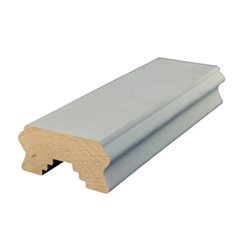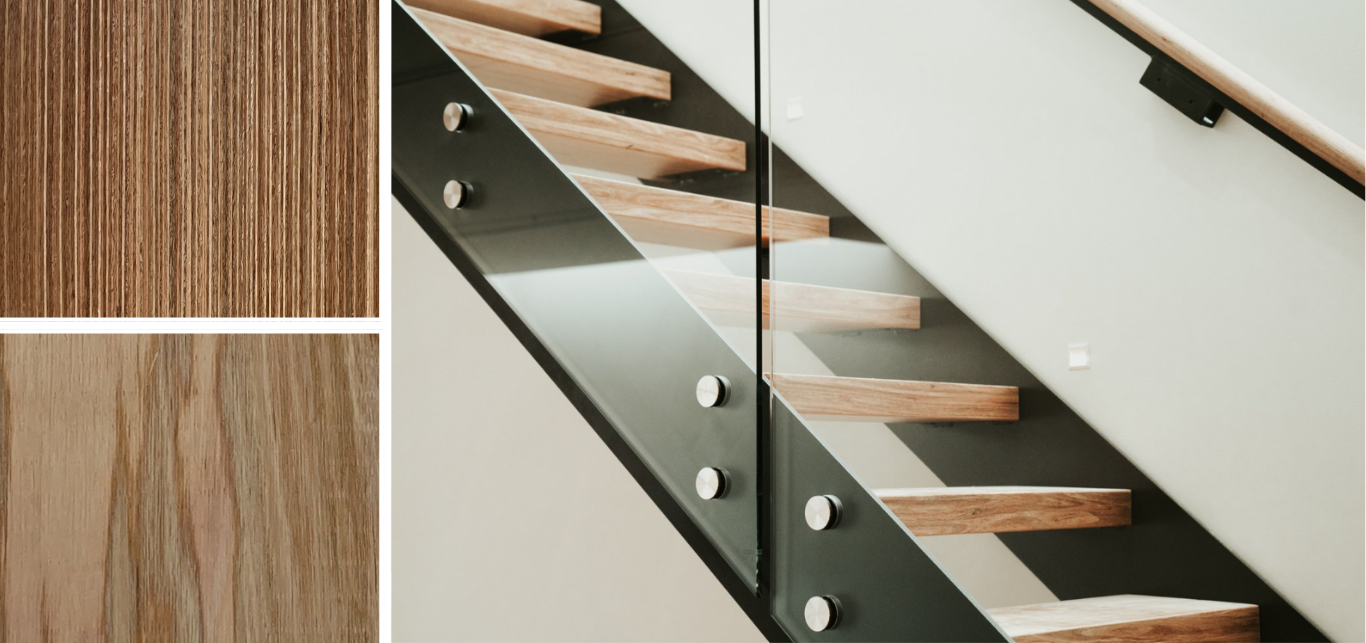Madie Wray
September 04 2022
Top 5 Handrails For Outdoor Use - Best Materials & Inspiration
Having been in the handrail and staircase business for more than 75 years, I like to think we know a thing or two about which handrails are best for outdoor use. Actually, I'd like to think we know an awful lot about it.
With so many different products on the market, choosing the right handrail for your deck, pergola, or outdoor set of stairs can start to feel a little overwhelming. It's hard to know which are the easiest to maintain, which are the cheapest, and which are going to give you a premium look/finish. By the end of this article we hope to help steer you in the right direction, so you can make the right decision for your specific circumstances!
Below, we've compiled our top 5 handrails for outdoor use + the pro's and cons to each! Check out the table in the conclusion section for a 1 to 1 comparison between the different materials.
Related Reading: How to Install A Wall Mounted Handrail

Top 5 Handrails For Outdoor Use
- STAINLESS STEEL
- TREATED PINE
- GALVANISED STEEL
- SPOTTED GUM
- MERBAU / KWILA
- CONCLUSION
1. Stainless Steel
When To Use Stainless Steel Handrail?
316 stainless steel is an extremely versatile material, available in both mirror and satin finishes. Of all the materials on this list, stainless steel is the best to use in marine and beachfront environments as it is completely water resistant and doesn’t require much maintenance after installation.
With this being said, 316 stainless steel should not be considered completely corrosion-proof. In order to keep your handrail looking its best, you should periodically polish your rail. We have personally found peek stainless steel polish to be best for this purpose, however other polishes should achieve a similar result.
Some other circumstances where we recommend using stainless steel (over other materials on this list) include:
- Moist/Humid environments;
- Some other instances where treated pine should be used include:
- Modern/Industrial style builds.
Some other circumstances where we recommend using stainless steel (over other materials on this list) include:
Types of Stainless Steel Handrail
Stainless steel handrails are available in a wide variety of different styles and sizes. Most commonly you will see 50.8mm (2 inch) diameter tubes being used in commercial settings, however, 38.1mm tubes, rectangular and square varieties are also popular choices!
Round Stainless Steel Handrail

Our round stainless pipe's are available in 2 different sizes: 38.1mm and 50.8mm. The latter is more commonly used in commercial settings, and is therefore far more popular than the smaller size. We recommend the 50.8mm in most circumstances, unless the width of your stairwell limits the size width of the rail.
Shop Our RangeSquare Stainless Steel Handrail

Square stainless steel handrail is popular in newer builds, where you're looking for something a little different! We absolutely love all the clean lines these handrails create.
Shop Our RangeRectangle Stainless Steel Handrail

If you're looking for something sleek, slimline and inobtrusive, rectanglular rail might be the way to go! It's important to add extra height to your posts if you intend to use shallow profiles like these however, as otherwise they won't meet code!
Shop Our RangeRelated Reading
If you are landing on this web page, then I am guessing that you are interested in doing a wire balustrade, which probably means that you already know what a wire balustrade is, but just in case this is not the case, maybe the best place for me to start is to very briefly explain exactly what it is.
Step By Step Guide To Wire Balustrade2. Treated Pine

What is Treated Pine?
Treated pine is a timber that has been chemically treated to give it better resistance to wood rot, decay and insects than it otherwise would have. Often it is stained green as a means of distinguishing it from untreated timbers, or pre-primed & ready to paint. You can read more about H3 treatment here.
These features make it perfect for use outdoors, and more specifically as handrail, especially when installed under a pergola/out of direct sunlight. As, while treated pine is better suited to external use than non-treated pine, it is still not as weatherproof as other species such as blackbutt, jarrah and spotted gum.
When To Use Treated Pine Handrails
When it comes to exterior rails, treated pine tends to be the most economical and popular choice. While it is a paint-grade product, and cannot be left clear (like other timber species on this list), its extremely low price point more than makes up for this fact!
Treated pine is a fantastic option for decking rails specifically, as these profiles tend to be much wider and bigger than other external handrails. This is because treated pine can be glued together to create larger profiles, whereas other outdoor species do not laminate as well. As a result, we do not offer our wider decking profiles in these species.
Some other instances where treated pine should be used include:
- Where there is a risk of insect damage;
- When you are looking to match other softwoods (such as pine decking etc.);
- When extremely long lengths of rail are required, as pine is the longest timber species currently available on the market.
Related Reading
Contrary to popular belief, not all timber species are created equal; some are inexpensive and easy to work with, like pine and meranti, while others are more durable and decorative, such as American oak and Jarrah. What’s important on one job, may not be on another, which is why we’ve compiled a list to help you decide which timber species might work for you, and which ones you should avoid.
How To Choose the Best Timber Species for Your ProjectTypes of Treated Pine Rail
LOSP/H3 Treated Pine Rail

Our LOSP/H3 treated pine rail is perfect for those looking for somthing that's primed and ready to go! Simply add your desired top coat, and you're off.
View Item3. Galvanised Steel
When To Use Treated Galvanised Steel Handrails
Galvanised steel is another budget-friendly option for outdoor handrails, as it is typically much cheaper than other metal rails. For example, galvanised steel tube costs $4 less per lineal metre on average than a 316 stainless steel equivalent, while fittings and joiners can cost $12-$14 less per piece! These savings are especially notable on large/commercial jobs.
In addition to being budget-friendly, galvanised handrails are also modular, making them a popular choice for DIY’ers. Absolutely no glue or welding is needed for these systems. They are designed to be assembled using only a hex key.
Due to their modular nature, galvanised tubes & fittings are often used to construct temporary handrails. They are both easily constructed and pulled apart, making them perfect for use as safety railing on job sites.
Galvanised fittings are also often used:
- In marine/waterfront settings;
- In instances where a wider variety/specific fittings are required, as there is a much larger variety available for galvanised steel than stainless steel;
- Where there is the possibility of the rail needing to be extended;
- Where the handrail is being powder coated;
- To achieve an industrial style look.
Types of Galvanised Steel Handrails
Stainless steel handrails are available in a wide variety of different styles and sizes. Most commonly you will see 50.8mm (2 inch) diameter tubes being used in commercial settings, however, 38.1mm tubes, rectangular and square varieties are also popular choices!
External Fit Galvanised Handrail (+Fittings)

External fit handrail fittings can be used to turn almost ANY sized galvanised pipe into a handrail. They're extremely versatile and easy to use, perfect for DIYers and handymen!
Shop Our RangeInternal Fit/Disability Handrail (+fittings)

The internal fit/disability range of fittings are designed to meet Australian disability standards (where a continuous handrail is required). The standard external fittings do not meet these standards.
Shop Our Range4. Spotted Gum Timber Handrail
When To Use Spotted Gum Handrail
Spotted gum is one of the most commonly used external timber species due to its natural weather resistance. The high oil content of gum species makes them perfect for use on decks, pergolas and as outdoor rails. This is true not only of spotted gum, but also of species like blackbutt, jarrah and kwila/merbau.
Spotted gum is an Australian-grown timber, popular for its mid-dark colouration and attractive grain. This makes it perfect for those looking for a natural finish timber. It does not need to be painted, but rather, simply needs a coat (or two!) of oil or clear lacquer.
Types of Spotted Gum Handrail
43mm Round Spotted Gum Handrail / Designer Rail Range

The 43mm round designer rail range is arguably one of our most popular handrail profiles. While not all of the timber species within this range can be used outdoors- both the spotted gum and blackbutt varieties can be!
View Item5. Kwila/Merbau Handrail
When to use Kwila/Merbau Handrail
Kwila/Merbau is one of the most commonly used outdoor timbers as it is more water resistant, split resistant, and weather resistant than other species. It is especially popular in coastal locations, as it able to withstand salt water environments better than most.
In addition to being used in coastal locations, Merbau/Kwila is also a fantastic choice for very hot, dry environments. While it needs to be oiled frequently to maintain it's rich colour and natural weather resistances, it's much better suited to direct sunlight than almost any other timber species.
Overall Kwila is a fantastic choice for anyone wanting a timber finish, but lives in a particularly hash environment!
Types of Kwila/Merbau Handrail
Kwila Decking Rail
This Kwila rail is a fantastic way to make a statement- measuring a whopping 134 x 38mm!
It can be left unfinished, oiled to maintain it's beautiful colour, or painted!
Conclusion
Which handrail material you choose to build your rail from largely comes down to personal preference & the style of your home/building. With that being said, we have created an easy to navigate chart to help make the decision a little easier.
| Material | water resistant | sun resistant | low maintenance | budget friendly | premium product |
|---|---|---|---|---|---|
| 316 Stainless | ✓ | ✓ | ✓ | ─ | ✓ |
| Treated Pine | ─ | ─ | ─ | ✓ | ✖ |
| Galvanised Steel | ✓ | ✓ | ✓ | ✓ | ✖ |
| Spotted Gum | ✓ | ─ | ✓ | ─ | ✓ |
| Kwila | ✓ | ✓ | ✓ | ─ | ✓ |
As you can see, metal products tend to be more water and sun resistant than timber products, but are not always considered a "premium product", or right for every circumstance!
If you are looking for advice on which handrail material is going to best suit your build/project, feel free to give us a call in the office on 08 8346 8211 or pop in for a chat! We're more than happy to help you with any questions or queries you may have.
People Also Read

Australian Made Sustainable Timber Alternatives | Working With Crafted Hardwoods
Over the last 80 years, Hammersmith has had the privilege of working alongside countless Australian-owned and operated businesses: from stairbuilders, to timber merchants, to furniture makers.

What is Finger-jointed Timber?

What is EWP Timber / Engineered Wood Product?
EWP (Engineered Wood Product) is real timber! It is made by stacking and gluing together multiple thin layers (or veneers) of solid timber on top of one another, usually with the grain running in the same direction. These layers are then compressed and glued together to form a strong, stable, and uniform piece of timber that can be used in visible, finished applications, such as stair treads, handrails, and wall panelling.

